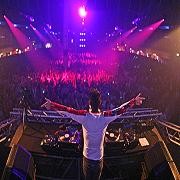| Origin In the early 1980s, the German composer Klaus Schulze composed several albums of experimental, atmospheric \\\\\\\"space music\\\\\\\". Two of his albums from the 1980s include the word \\\\\\\"trance\\\\\\\" in their titles: Trancefer (1981) and En=Trance (1987)[2] Some of the earliest identifiable trance recordings came from The KLF, a UK-based acid house group. The most notable of these were the original 1988 / 1989 versions of \\\\\\\"What Time Is Love?\\\\\\\" and \\\\\\\"3 a.m. Eternal\\\\\\\", along with \\\\\\\"Kylie Said Trance\\\\\\\" (1989) and \\\\\\\"Last Train to Trancentral\\\\\\\" (1990). The KLF labeled these early recordings \\\\\\\"Pure Trance\\\\\\\". While the KLF\\\\\\\'s works are clear examples of proto-trance, two songs, both from 1990, are widely regarded as being the first \\\\\\\"true\\\\\\\" trance records. The first is Age of Love\\\\\\\'s self-titled debut single which they released in early 1990 and is seen a basis for the original trance single. The second track was Dance 2 Trance\\\\\\\'s \\\\\\\"We Came in Peace\\\\\\\", the b-side of their own self-titled debut single. Another influential song was Future Sound Of London\\\\\\\'s \\\\\\\"Papua New Guinea\\\\\\\" (1991). The trance sound beyond this acid-era genesis is said to have been an off-shoot of Detroit techno in German clubs during the very early 1990s. Germany is often cited as a birthplace of trance culture and is celebrated once a year in the \\\\\\\"Love Parade\\\\\\\" festival. Some of the earliest pioneers of the genre include Jam El Mar, Oliver Lieb, and Sven Väth, who all produced numerous tracks under multiple aliases. Trance labels such as Eye Q, Harthouse, Rising High Records, FAX +49-69/450464 and MFS Records were based in Frankfurt, and Berlin. Commercial trance By the mid-1990s trance, specifically progressive trance, had emerged commercially as one of the dominant genres of dance music. Progressive trance has set in stone the basic formula of modern trance by becoming even more focused on the anthemic bass lines and lead melodies. Compositions continued to contain incremental changes (aka progressive structures), sometimes composed in thirds (as BT frequently does). Meanwhile, a different type of trance, generally called uplifting trance, was becoming popular. Uplifting trance had buildups and breakdowns that were longer and more exaggerated, with more easily identifiable tunes and anthems. Many such trance tracks follow a set form, featuring an introduction, steady build, a breakdown, and then an anthem, a form called \\\\\\\"build-breakdown-anthem\\\\\\\". Artists like Tiësto, Armin van Buuren, Paul van Dyk, Robert Miles, Above & Beyond(Oceanlab), Darren Tate, Ferry Corsten, Johan Gielen, ATB and Paul Oakenfold came to the forefront as premier producers and remix artists. These and others led trance to a new commercialized forefront and paved the way for artists like Trizet in France and Third Element in the United States Many of these producers also DJ\\\\\\\'d in clubs playing their own productions as well as those by other trance DJs. By the end of the 1990s, trance remained commercially huge, but had fractured into an extremely diverse genre. Some of the artists that had helped create the trance sound in the early and mid-1990s had, by the end of the decade, abandoned trance completely in favor of more underground sounds—artists of particular note here include Pascal F.E.O.S. and Oliver Lieb. Many trance DJs are well into their own radio shows broadcast throughout Europe, the United States other countries all over the globe. Examples are \\\\\\\"A State of Trance\\\\\\\" created and hosted by Armin Van Buuren and \\\\\\\"Trance Around the World\\\\\\\" created and hosted by Above and Beyond. Artists such as Mike Foyle are also classically trained pianists (and alike) which assists them with sophisticated and musically pleasing melodies. Some of the most popular weekly trance radio shows and podcasts include: Armin van Buuren - A State of Trance, John De La Mora - Trance Nation, Above & Beyond - Trance Around The World, Tiesto - Tiesto\\\\\\\'s Club Life, Paul van Dyk - VONYC Sessions, and Ferry Corsten - Corsten\\\\\\\'s Countdown. [edit] Diversification As an alternative evolution some artists have attempted to fuse trance with other genres such as drum\\\\\\\'n\\\\\\\'bass. Others have experimented with more minimalist sounds. Frustrated, extreme versions of trance have mutated through gabba into fringe genres of \\\\\\\"hard trance\\\\\\\" or \\\\\\\"hardstyle\\\\\\\" overlapping with hardcore and terrorcore. Trance music appears frequently on the Internet with the abundance of legal music download sites, including the likes of Juno Download, and Beatport. As a result, both commercial and progressive trance now have a much larger presence, with big-draw artists such as Sasha, Tiësto, ATB, Markus Schulz, Armin van Buuren, BT, Paul van Dyk, Ferry Corsten, Above & Beyond, Paul Oakenfold, Schiller, Solarstone, Christopher Lawrence and George Acosta. by Wikipedia.org |
